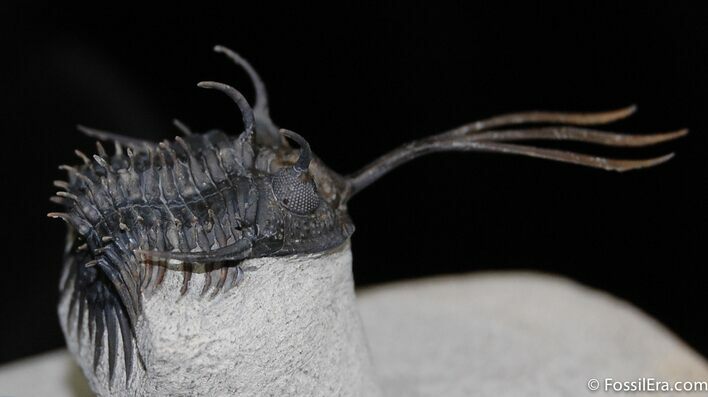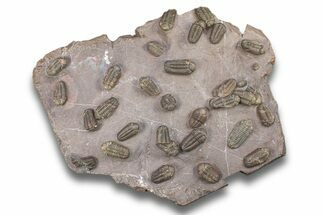This Specimen has been sold.
Trident Nosed Walliserops With Enrolled Phacops
Here is one of the strangest, and impressive species of trilobites known, Walliserops trifurcatus. One can only guess at the purpose of the weird trident like appendage jutting out in front of it's head. The tail of the Walliserops is tucked down and it's 1.6 inches around the curve. Below it's pygidium (tail) there is another passenger, a partially enrolled phacops.
Yes, the trident and all of the free standing spines on this beauty are real (unlike so many on the market). A number of the small free standing spines still have some of the original matrix clinging to them. They were painstakingly prepped out of the solid limestone using air abrasives under microscope. This piece likely took close to 40 hours of work to prepare.
The only restoration work done to the Walliserops is around a hairline crack through the head, the base of the trident and some very minor touchups of surface scratches that I made (1-2%). Nothing has been added to either trilobite on this piece.
Yes, the trident and all of the free standing spines on this beauty are real (unlike so many on the market). A number of the small free standing spines still have some of the original matrix clinging to them. They were painstakingly prepped out of the solid limestone using air abrasives under microscope. This piece likely took close to 40 hours of work to prepare.
The only restoration work done to the Walliserops is around a hairline crack through the head, the base of the trident and some very minor touchups of surface scratches that I made (1-2%). Nothing has been added to either trilobite on this piece.
Walliserops is a fascinating ancient arthropod that scoured the bottom of a shallow sea floor. It is placed in a genus of spiny, phacopid (acastid) trilobites and it is found in Lower to Middle Devonian (441-358 mya) rocks from Morocco. All species of Walliserops share the spectacular three-pronged "trident" that rises from the glabella. They also have horns over their eyes and intimidating spines along their backs.
Walliserops was highly specialized to deal with an oceanic wonderland in the diverse and dangerous Age of Fish. Specialization is a key difference from the more primitive “bugs” that emerged in the Cambrian.
Walliserops displays an unusual departure from bilateral symmetry. A notable example is the curved occipital spine of W. hammii, which takes a noticeable curl to one side. The regular development of these features in multiple specimens suggests a genetically controlled feature of the genus, not mutation or pathology. Some exceptions to bilateral symmetry can be explained by adaptations that allowed the trident to be held off the sea floor while walking.
The trident's function is an intriguing mystery. Many believe it was used to stir the ocean floor to better scavenge for food. Such a large adornment would have required significant energy and nutrient investment. Although a number of suggestions have been made (e.g. sensory apparatus, disguise or protection), many experts support an idea that the trident served as "horns" similar to present day beetles.
Morroco is an exciting place for discovering new and diverse species that lived in an ancient ocean that covered the northern reaches of the Sahara Desert. All three currently described Walliserops species come from the same strata near Foum Zguid in southern Morocco, though other locations have yielded new trilobites to study. This region is hailed as one of the great fossil treasure troves in the world.
Walliserops was highly specialized to deal with an oceanic wonderland in the diverse and dangerous Age of Fish. Specialization is a key difference from the more primitive “bugs” that emerged in the Cambrian.
Walliserops displays an unusual departure from bilateral symmetry. A notable example is the curved occipital spine of W. hammii, which takes a noticeable curl to one side. The regular development of these features in multiple specimens suggests a genetically controlled feature of the genus, not mutation or pathology. Some exceptions to bilateral symmetry can be explained by adaptations that allowed the trident to be held off the sea floor while walking.
The trident's function is an intriguing mystery. Many believe it was used to stir the ocean floor to better scavenge for food. Such a large adornment would have required significant energy and nutrient investment. Although a number of suggestions have been made (e.g. sensory apparatus, disguise or protection), many experts support an idea that the trident served as "horns" similar to present day beetles.
Morroco is an exciting place for discovering new and diverse species that lived in an ancient ocean that covered the northern reaches of the Sahara Desert. All three currently described Walliserops species come from the same strata near Foum Zguid in southern Morocco, though other locations have yielded new trilobites to study. This region is hailed as one of the great fossil treasure troves in the world.
SPECIES
Walliserops trifurcatus and Phacops
AGE
LOCATION
Foum Zguid Morocco
FORMATION
N/A
SIZE
2.6"
CATEGORY
SUB CATEGORY
ITEM
#482
We guarantee the authenticity of all of our specimens.
 Reviews
Reviews

















